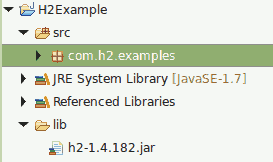H2 Database Connection Pool Example

In this H2 Database Connection Pool Example explains about the implementation of connection pool using H2 Database
H2 is an open source software implementation of Java SQL database. The main features of H2 are.
- Very fast, open source, JDBC API
- Embedded and server modes; in-memory databases
- Browser based Console application
- Small footprint: around 1.5 MB jar file size
Reference -> http://www.h2database.com/html/main.html
Usage Of H2 JdbcConnectionPool Class
Creating a new connection for each user can be time consuming, which affects the over all performance of the system. In order to solve this issue, we are using a connection pool.
In H2 database, we can implement JDBC Connection Pool without using any third party libraries. It is is in-built on H2, we are using JdbcConnectionPool class in order to create the jdbc connection pool.
Required Libraries
For using H2 database, You need to download
Project Structure

Simple H2 Database Connection Pool Example
In below code you can see that we are using following H2 JDBC URL jdbc:h2:~/test for connecting the database, here 'test' is in the user home directory
In the method getConnectionPool(), we are using JdbcConnectionPool class for creating the Connection Pool
import java.sql.BatchUpdateException;
import java.sql.Connection;
import java.sql.PreparedStatement;
import java.sql.SQLException;
import java.sql.Statement;
import org.h2.jdbcx.JdbcConnectionPool;
import org.h2.tools.DeleteDbFiles;
// H2 Database ConnectionPool Example
public class H2DatabaseConnectionPoolExample {
private static final String DB_DRIVER = "org.h2.Driver";
private static final String DB_CONNECTION = "jdbc:h2:~/test";
private static final String DB_USER = "";
private static final String DB_PASSWORD = "";
public static void main(String[] args) throws Exception {
try {
// delete the database named 'test' in the user home directory for initialization
DeleteDbFiles.execute("~", "test", true);
batchInsertWithStatement();
batchInsertWithPreparedStatement();
} catch (SQLException e) {
e.printStackTrace();
}
}
private static void batchInsertWithPreparedStatement() throws SQLException {
JdbcConnectionPool jdbcConnectionPool = getConnectionPool();
Connection connection = jdbcConnectionPool.getConnection();
PreparedStatement preparedStatement = null;
String Query = "INSERT INTO PERSON" + "(id, name) values" + "(?,?)";
try {
connection.setAutoCommit(false);
preparedStatement = connection.prepareStatement(Query);
preparedStatement.setInt(1, 4);
preparedStatement.setString(2, "Rockey");
preparedStatement.addBatch();
preparedStatement.setInt(1, 5);
preparedStatement.setString(2, "Jacky");
preparedStatement.addBatch();
int[] countWithoutException = preparedStatement.executeBatch();
System.out.println("OK: countWithoutException = " + countWithoutException.length);
connection.commit();
} catch (BatchUpdateException e) {
System.out.println("Exception Message " + e.getLocalizedMessage());
} catch (Exception e) {
e.printStackTrace();
} finally {
preparedStatement.close();
connection.close();
jdbcConnectionPool.dispose();
}
}
private static void batchInsertWithStatement() throws SQLException {
JdbcConnectionPool jdbcConnectionPool = getConnectionPool();
Connection connection = jdbcConnectionPool.getConnection();
Statement stmt = null;
try {
connection.setAutoCommit(false);
stmt = connection.createStatement();
stmt.execute("CREATE TABLE PERSON(id int primary key, name varchar(255))");
stmt.addBatch("INSERT INTO PERSON(id, name) VALUES(1, 'A')");
stmt.addBatch("INSERT INTO PERSON(id, name) VALUES(2, 'B')");
stmt.addBatch("INSERT INTO PERSON(id, name) VALUES(3, 'C')");
int[] countWithoutException = stmt.executeBatch();
System.out.println("OK: countWithoutException = " + countWithoutException.length);
connection.commit();
} catch (BatchUpdateException e) {
System.out.println("Exception Message " + e.getLocalizedMessage());
} catch (Exception e) {
e.printStackTrace();
} finally {
stmt.close();
connection.close();
jdbcConnectionPool.dispose();
}
}
// Create H2 JdbcConnectionPool
private static JdbcConnectionPool getConnectionPool() {
JdbcConnectionPool cp = null;
try {
Class.forName(DB_DRIVER);
} catch (ClassNotFoundException e) {
System.out.println(e.getMessage());
}
cp = JdbcConnectionPool.create(DB_CONNECTION, DB_USER, DB_PASSWORD);
return cp;
}
}
Output
Inserted Count Using SQL Statement = 3 Inserted Count Using SQL PreparedStatement = 2